Overgrown hind foot with dead and diseased frog material.
My apprentice liked to tease me about how I have the nose of a bloodhound. I am pretty sensitive to the smell of thrush and notice it right away. A healthy hoof should not smell stinky. Dirt has a neutral smell, unless of course they just stepped in manure. In my experience, thrush is common in horses with unhealthy feet but it is not normal. But what is thrush exactly? How concerned should you be if your hoofcare provider tells you your horse has thrush? And how can you treat it?
Thrush
Thrush is an infection (either bacterial, fungal, or both, how fun) of the frog, usually present in the central sulcus and/or collateral grooves. It can smell pretty bad. It often produces black oozing discharge. The area affected is usually tender, if not outright painful, to the touch. If it progresses, it can eat into the sensitive structures below. Thrush is an infection – it usually does not heal on its own. It is painful to your horse and should be addressed immediately. Contrary to popular belief, most horses don’t always get thrush from unsanitary living conditions (though once you have thrush, you may have to change their living conditions to help it heal). Thrush develops when there is dysfunction in the back of the foot. I usually find it in contracted heels, some club feet, neglected feet, and some shod horses. I have trimmed horses at the same barn living in the same conditions and those with healthy feet will not have thrush.
Treatment Options
There are lots of thrush treatments out there and everyone you talk to will have their sworn favorite. I encourage owners to use something that will not harm healthy tissue, and that will not sting or burn. Imagine what you might like to put on an open wound on yourself to promote healing. If you have to use gloves to apply it (unless you’re just trying to keep your hands clean), then it’s not safe for your horse’s infected “wound” in the central sulcus. You need something gentle and effective.
Pete Ramey Goo
The go-to remedy for many thrush cases is “Pete Ramey Goo.” The recipe is 1/2 part triple antibiotic ointment + 1/2 part athletes foot cream (active ingredient: clotrimazole). Mix the two together and squeeze into a syringe, preferably one with a long enough tip you can reach into deep crevices. Squirt as far into the central sulcus/affected area as you can reach and spread around. Read here for the treatment method and specific syringe Pete Ramey recommends: http://www.hoofrehab.com/thrush_treatment.htm.
Red Horse Products
“Pete Ramey Goo” works well but buying those two ingredients can get expensive if you’re treating multiple horses for a long period of time. Red Horse Products makes several options that work just as good, and you’re avoiding exposing your horse to antibiotics unnecessarily.
Sole Cleanse – designed for daily use, this is a gentle spray to flush out bacteria as a stand alone thrush treatment or before you apply one of the following products.
Artimud – designed for shallow crevices and cracks. It’s a thick clay with a putty like consistency, so it stays where you put it, and a little goes a long way.
Hoof Stuff – designed for deep tight holes that need to be packed, like an infected central sulcus. May take a few tries to get the application down, very sticky and fibrous.
Field Paste – thick, paste like consistency, designed for horses who spend most of their time turned out.
Sole Paint – a hoof dressing you paint on, designed for horses who are kept in their stall more often that turned out.
*If you don’t know which one to choose, just pick the one you know you’ll apply regularly — they all have similar ingredients.*
Essential Oils
You may use essential oils on yourself at home and wonder if there is a use for them at the barn as well. Yes there is! Tea tree oil is the most well known and widely used essential oil for thrush. If you’re treating a deep, tender central sulcus, you may want to dilute the tea tree oil with coconut oil to avoid any reactions and for ease of application. If the thrush you’re treating is superficial (in the collateral grooves, on the sole, in the white line, or in old nail holes), tea tree oil neat/straight is a great choice. You have to use a high quality essential oil – anything less won’t be medically effective and could harm sensitive tissue. Poor quality oil companies don’t disclose their exact ingredients. I recommend Ameo or DoTerra brand oils.
Treatment Tips
- Work with your hoofcare provider to remove (nipper or cut away) the dead areas of the frog. The central sulcus may need to be opened up to allow for better airflow and treatment.
- Start picking your horse’s feet out as often as you can. But be careful, a jab with a hoofpick in a sensitive area can be painful.
- Whatever thrush treatment you use, commit to it. Apply every day or a few times a week until you see a difference. If you don’t see a difference within a few weeks, discontinue use and try a different product. Every horse is different and some respond better to some treatments than others. Consistency is the key!
- Keep your horse on a tight trimming schedule. Their thrush will heal from correct trimming and effective topical treatment. The two go hand in hand. I’ve worked on horses whose owners refused to stay on a schedule with topical treatment and I could only get so far with trimming.
- Follow your hoofcare providers advice on any changes to lifestyle. If my client will be consistent with treatment, I want their horse to have access to as much turnout as possible. Along with trims and treatment, movement is helpful for overall hoof health.
What Thrush Looks Like
*In most of these pictures, the thrush is lurking between the heel bulbs in the central sulcus and also in the collateral grooves. You won’t always see black discharge or even necessarily smell it until you start searching.*
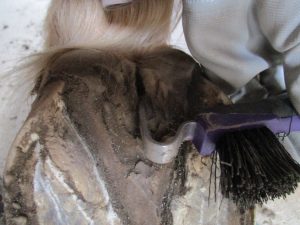
My hoofpick is halfway into the deep crevice here. The frog doesn’t look too diseased but it is black, stinky, and tender where my hoofpick is.
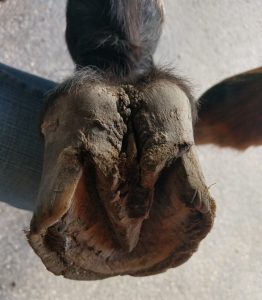
Deep central sulcus, contracted heel bulbs, high heels – a lot going on here. This is a clubby foot that is very overgrown. You can see bumpy inflamed skin near the hairline.
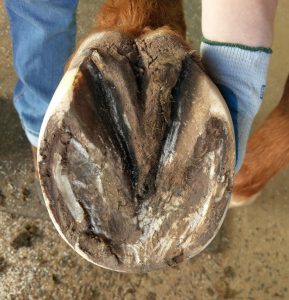
This hoof has thrush in the collateral grooves – see the black lines and white crumbly stuff?

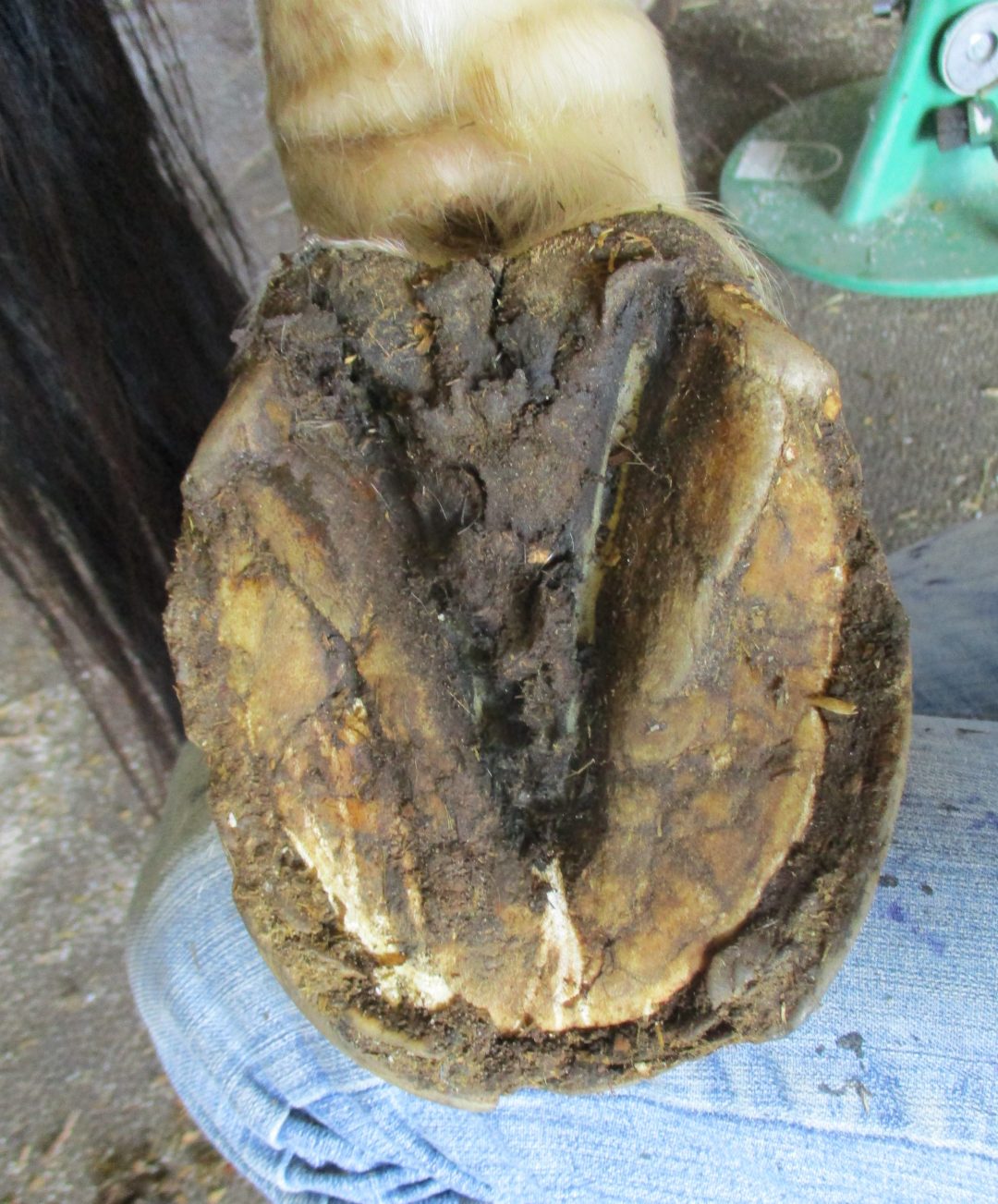
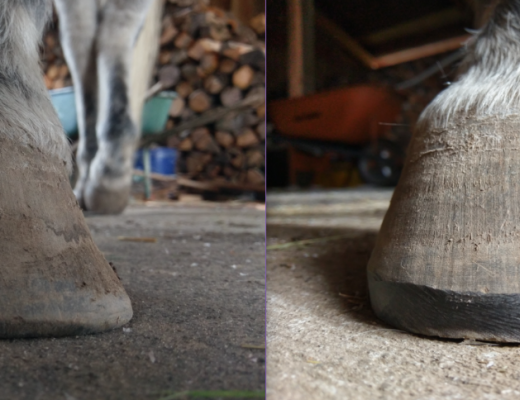
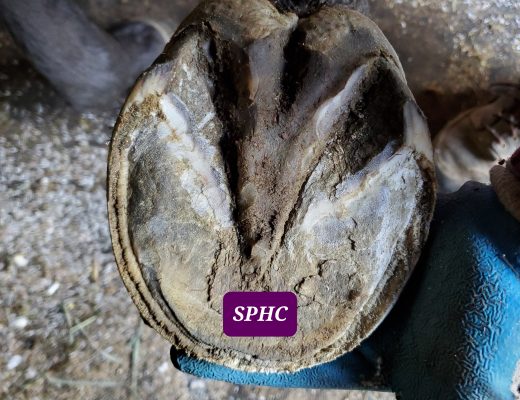
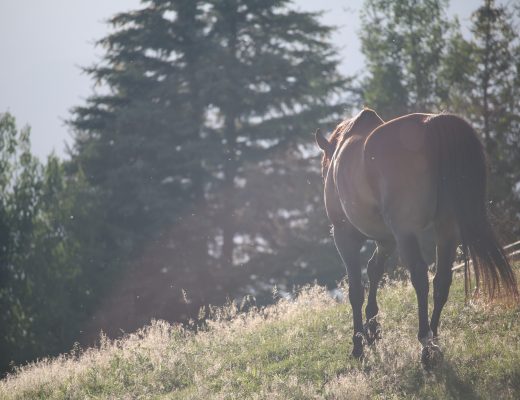
1 Comment
Samantha
June 27, 2022 at 7:14 pmHi thank you for this information and photos. You have clearly outlined and shown the problem that my old pony has at the moment with thrush in the central sulcus. Its been a very wet winter here. Will follow your tea tree oil recommendation after a good disinfection of the area and a trim. Thanks Sam